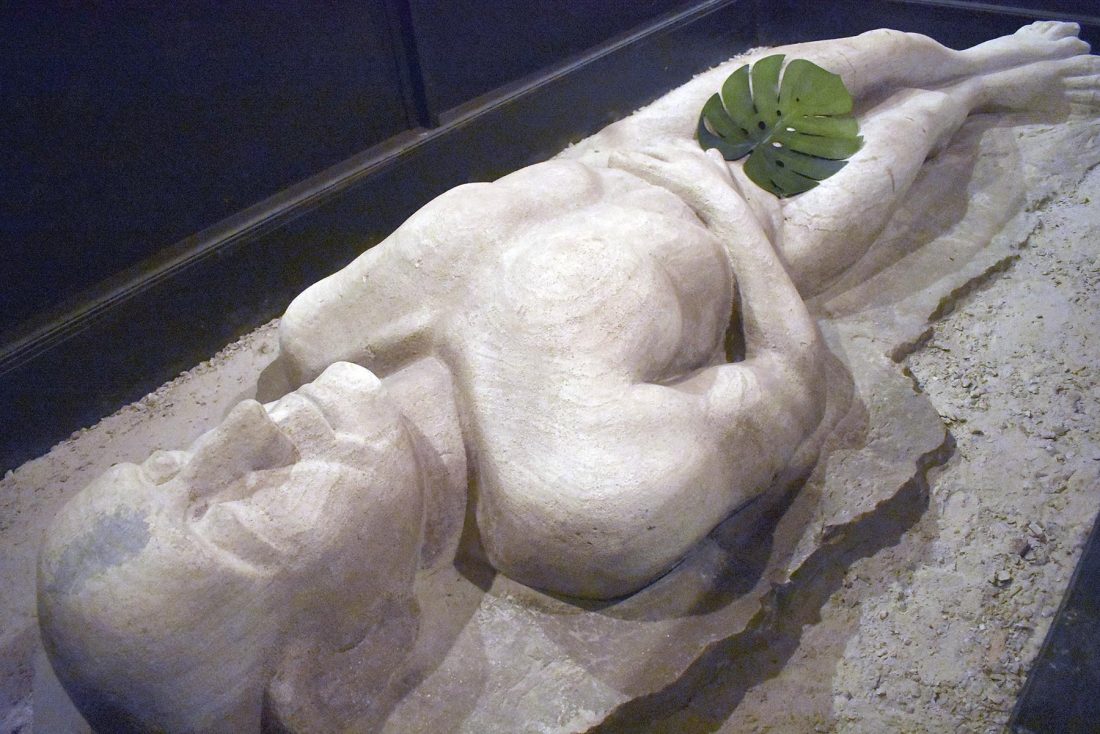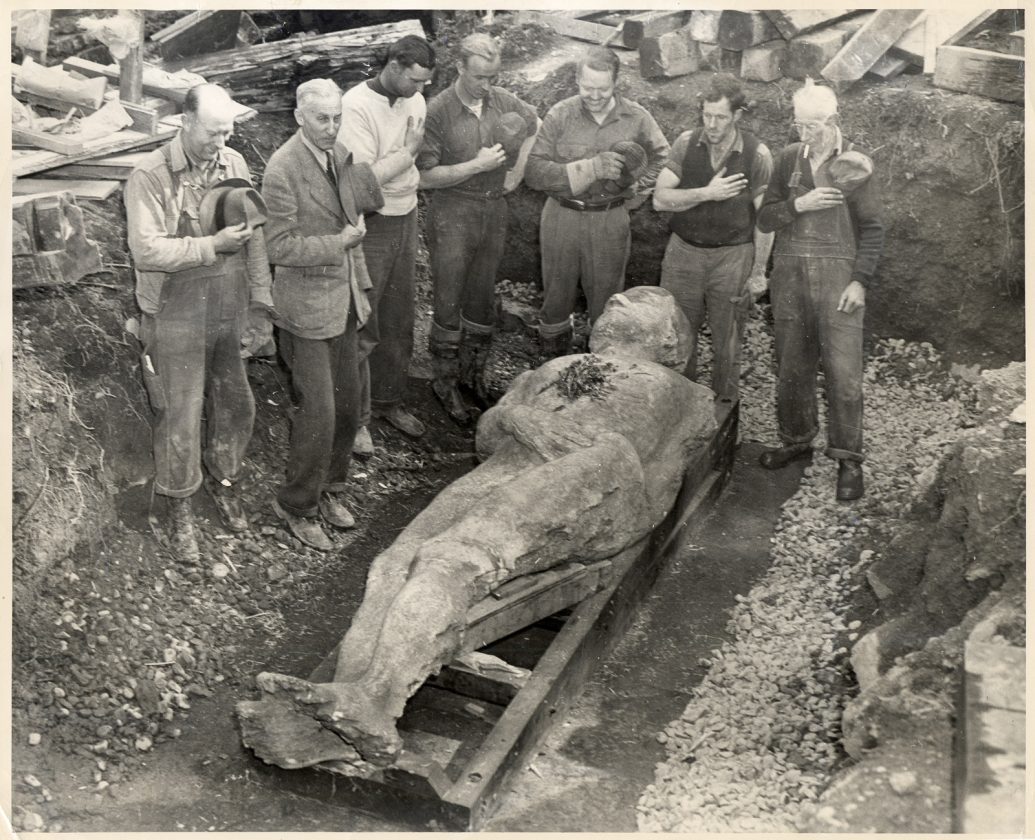Cardiff Giant turns 150
Fort Museum & Frontier Village is giving him a birthday bash
-
-Photo from The Farmers’ Museum, Cooperstown, New York
The original Cardiff Giant was dug up in Cardiff, New York, in 1869.
-
-Photo from The Farmers’ Museum, Cooperstown, New York
People paid 50 cents to see the Cardiff Giant in 1869. That’s about $10 today.
-
-Messenger photo by Elijah Decious
The Cardiff Giant will celebrate his 150th birthday this week at Fort Museum & Frontier Village.

-Messenger photo by Elijah Decious
The Cardiff Giant will celebrate his 150th birthday this week at Fort Museum & Frontier Village.
Get ready to party with Fort Dodge’s most infamous hoax on his 150th birthday this Wednesday at the Fort Museum and Frontier Village.
From 5 to 8 p.m., visitors can enjoy a giant cake, decorate paper maches and make their own “humbug,” such as a “jackalope,” which was invented by the same person who came up with the Cardiff Giant.
Additional food, prizes and trinkets, like Cardiff Giant cotton candy bath bombs, will also be available at the P.T. Barnum circus-themed party. Admission is $5, or free for children 5 and younger.
For just 50 cents — the then-high price visitors paid in 1869 to see the newly unearthed wonder — visitors can tack a visit to the replica of the Cardiff Giant onto their admission at a birthday party guaranteed to be historic.
The Cardiff Giant, concocted by New York tobacconist George Hull, was made from gypsum procured in a Fort Dodge quarry. The gypsum was shipped to Chicago, disguised as farm equipment to keep word about the project from getting out.

-Photo from The Farmers' Museum, Cooperstown, New York
The original Cardiff Giant was dug up in Cardiff, New York, in 1869.
“There was all sorts of mysticism,” that surrounded the project for years, said Heather Jensen, museum curator.
Hull, an atheist, was inspired to build the giant after an argument over Genesis 6:4 at a Methodist revival meeting. The verse says that “giants” once lived on earth.
In Chicago, it was sculpted into what visitors can see a replica of today. The sculptor poured acid on it to give it an authenticated, mummified look.
Shipped to Cardiff, New York, the 10-foot giant was “discovered” by workers digging a well in a spot directed by William Newell.
The original Cardiff Giant remains in Cooperstown, New York. A replica in Fort Dodge, built in 1980, was sculpted out of one solid piece of gypsum, which took the museum years to procure.

-Photo from The Farmers' Museum, Cooperstown, New York
People paid 50 cents to see the Cardiff Giant in 1869. That’s about $10 today.
P.T. Barnum, a household name known for his circus, attempted to buy the Cardiff Giant from Hull for $50,000 when he saw the crowds it attracted. They came by the wagon-full from many miles away to pay what was then a very high price for entertainment.
When Hull refused to sell, Barnum constructed his own giant, peddling it around the country and attempting to bill it as the “original” giant, pitting Hull’s as a replica.
But when Barnum and Hull both showed their giant in the same town at the same time a few months later, the jig was up.
“It’s a convoluted story that ended with them exhibiting their giants in the same town at the same time,” said Jensen.
Barnum’s replica is now housed at Marvin’s Marvelous Mechanical Museum in Farmington Hills, Michigan. Jensen said it looks very different with a black color, likely due to the type of acid poured on it during its manufacture.
Undeterred though, Barnum went on to create another type of giant, this one made of an encasing filled with meat and animal entrails to give visitors the impression of a real body that likely smelled like a decayed one and would put out a visceral display if cut.
“He still kept pushing on with the idea after people figured it out,” Jensen said.
From that point on, people would pay to see Barnum’s latest exhibits, even if they didn’t believe they were real, just to see what crazy hoax he had come up with this time.
But it all started with Fort Dodge, and it’s a part of history residents should know, Jensen said.
“It’s something that a lot of people have heard about, but not a lot of people know that it started in Fort Dodge or that all of (the replicas) started in Fort Dodge,” she said. “Gypsum is a big industry even to this day, but was extremely important in the beginning of the town. All the wealthy benefactors that supported this town got wealthy from the gypsum industry.”
And, perhaps, a fraction of that wealth stemmed from a giant hoax.
“It’s a core part of our history that ties the town together,” Jensen added. “All of it came from this area, it was Fort Dodge inspired.”
You may already know the work of the replica sculptor, Cliff Carlson, even if you’ve never seen the Cardiff Giant. His impressions grace the side of the YMCA building — something his own family didn’t even know he did until a recent visit.
Carlson finally got the right piece of gypsum in 1980, 16 years after the museum expressed interest in the project. Then, his tent fell down in a storm and cracked the once flawless piece. Visitors can see the crack in the giant’s left thigh today.
Enjoy a slice of cake and a piece of history as you celebrate the giant’s tale that started in Fort Dodge’s early days.
Those wishing to visit the museum must do so by 4 p.m., before the party starts. The museum will close as the Cardiff Giant’s birthday bash starts.








